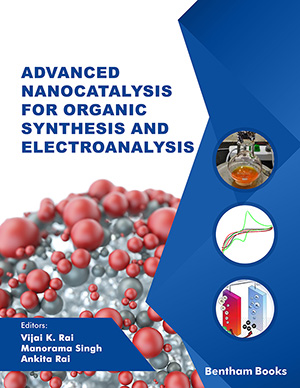
Abstract
This account reviews some innovative (“non-classical”) synthetic strategies for the formation of CP bonds developed during the last decades. It provides examples of the most important milestones in this field, highlighting the state-of-art of functional phosphoruscontaining molecules. Among these are the direct functionalization of organic substrates through chlorine-free reactions with elemental phosphorus, syntheses based on phosphinidene (RP) transfer, phosphorylating methodology employing multiple bonds containing P(III) compounds, reactions with stable heterocyclic carbenes, and synthetic approaches using phosphaethynolate and bis(trichlorosilyl)phosphide salts.
Keywords: C-P bond forming reactions, elemental phosphorus, phosphinidene transfer, phospha-Wittig reaction, phospha-Fritsch- Buttenberg-Wiechell rearrangement, phosphaalkynes, phosphaalkenes, phosphinylidene carbenoids, phosphaethynolate anion, bis(trichlorosilyl) phosphide salts.
Current Organic Chemistry
Title:New Trends in the Development of C-P Bond Forming Reactions
Volume: 25 Issue: 17
Author(s): Vadim D. Romanenko*
Affiliation:
- V.P. Kukhar Institute of Bioorganic Chemistry and Petrochemistry, National Academy of Sciences of Ukraine, 1-Murmanska Street, Kyiv-94, 02660,Ukraine
Keywords: C-P bond forming reactions, elemental phosphorus, phosphinidene transfer, phospha-Wittig reaction, phospha-Fritsch- Buttenberg-Wiechell rearrangement, phosphaalkynes, phosphaalkenes, phosphinylidene carbenoids, phosphaethynolate anion, bis(trichlorosilyl) phosphide salts.
Abstract: This account reviews some innovative (“non-classical”) synthetic strategies for the formation of CP bonds developed during the last decades. It provides examples of the most important milestones in this field, highlighting the state-of-art of functional phosphoruscontaining molecules. Among these are the direct functionalization of organic substrates through chlorine-free reactions with elemental phosphorus, syntheses based on phosphinidene (RP) transfer, phosphorylating methodology employing multiple bonds containing P(III) compounds, reactions with stable heterocyclic carbenes, and synthetic approaches using phosphaethynolate and bis(trichlorosilyl)phosphide salts.
Export Options
About this article
Cite this article as:
Romanenko D. Vadim *, New Trends in the Development of C-P Bond Forming Reactions, Current Organic Chemistry 2021; 25 (17) . https://dx.doi.org/10.2174/1385272825666210610153954
| DOI https://dx.doi.org/10.2174/1385272825666210610153954 |
Print ISSN 1385-2728 |
| Publisher Name Bentham Science Publisher |
Online ISSN 1875-5348 |
Call for Papers in Thematic Issues
Advances of Heterocyclic Chemistry with Pesticide Activity
Global food safety and security will continue to be a global concern for the next 50 years and beyond. Plant diseases have had a significant impact on food safety and security throughout the entire food chain, from primary production to consumption. While conventional chemical pesticides have been traditionally used for ...read more
Carbohydrates conversion in biofuels and bioproducts
Biomass pretreatment, hydrolysis, and saccharification of carbohydrates, and sugars bioconversion in biofuels and bioproducts within a biorefinery framework. Carbohydrates derived from woody biomass, agricultural wastes, algae, sewage sludge, or any other lignocellulosic feedstock are included in this issue. Simulation, techno-economic analysis, and life cycle analysis of a biorefinery process are ...read more
Catalytic C-H bond activation as a tool for functionalization of heterocycles
The major topic is the functionalization of heterocycles through catalyzed C-H bond activation. The strategies based on C-H activation not only provide straightforward formation of C-C or C-X bonds but, more importantly, allow for the avoidance of pre-functionalization of one or two of the cross-coupling partners. The beneficial impact of ...read more
Cutting-edge technology for the development of electrochemical sensors
Electrochemistry based point of care diagnostics is a powerful tool which can revolutionize the current concept of personalize health care industry. There have been several efforts to amalgamate cutting edge technologies (nanotechnology, surface technology, anti-biofouling strategies) while developing assays. The success of each electrochemical sensor is very dependable upon how ...read more
Related Journals
 47
47
- Author Guidelines
- Graphical Abstracts
- Fabricating and Stating False Information
- Research Misconduct
- Post Publication Discussions and Corrections
- Publishing Ethics and Rectitude
- Increase Visibility of Your Article
- Archiving Policies
- Peer Review Workflow
- Order Your Article Before Print
- Promote Your Article
- Manuscript Transfer Facility
- Editorial Policies
- Allegations from Whistleblowers
- Announcements


























